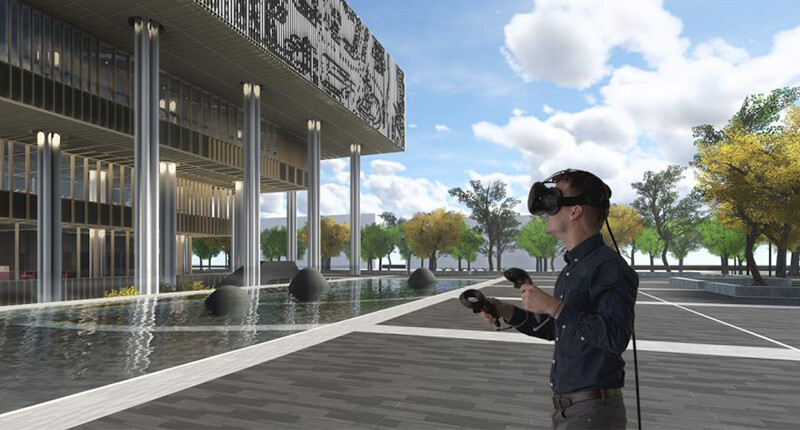SmartVizX is a company founded by two experienced architects, Gautam and Tithi, who have a combined experience of more than 40 years. As a result, we have a first-hand experience of the problems faced by the AEC industry and aim to solve that with Trezi which uses virtual reality in architecture, construction, and engineering to change the design experience for all stakeholders in the industry.
Right from collaboration issues between stakeholders arising due to the absence of a single version of the truth to the difficulty in effectively communicating design intent, it has been pretty clear that the community, as a whole, is in urgent need of a solution that aims to resolve the innate problems existing currently within the AEC industry.
With Trezi, we aim to transform the design experience and address a number of current challenges, as mentioned below.
Collaboration
AEC, unlike many other industries, has a large and diverse set of stakeholders: architects, designers, building product suppliers, plumbers, project managers, and vendors, etc., are all part of a typical project. The sheer number of stakeholders involved within a project, working in silos, leads to many issues with regards to collaboration. Situations such as these demands a single version of the truth on which all of these stakeholders can agree upon.
Collaboration saves time, which equals precious money in a segment like AEC where the cost of delays or errors is extremely high. In addition, the collaboration also helps all stakeholders in the project produce far better work and reduce inefficiencies.
Trezi aims to resolve the current problems faced by this active community by having a single version of the truth through a virtual meeting platform where designers working in different offices, geographies and time zones can work on and save changes that are being made in real-time. Now, you can say goodbye to confusion caused by different versions of the design model within a single project.
Presenting to your clients
First impressions matter, especially in design. Ever wondered why your client doesn’t ‘understand’ design? It doesn’t have to be that way any longer.
With Trezi, we use virtual reality and other immersive technologies to enable anyone to understand the space in a project better. Unlike traditional 2D designs, with Trezi, your client can be ‘in’ the design through virtual reality architectural walkthroughs and virtual tours and make changes on the go, if they wish to explore how a certain segment looks.
You can not only wow your client with Trezi, but you can also involve them in the project.
Letting a client play an active role in the project and helping them understand the space better goes a long way in reducing the iterations that take place at a late stage, in the course of the project.
Cost-saving
The number of iterations that take place in a traditional design process consumes a huge amount of resources, be it man-hours or time. Traditionally, the rendering process takes more than a day and even then it could be rejected by the client if it doesn’t match his/her standards. This results in an architect going back to the drawing board and starting the entire process all over again.
With the emergence of the latest technologies, real-time VR rendering is possible and the changes can be made instantly, without going back to the drawing board.
Lack of standard tools
The problem we faced when we were introducing Trezi to architects was the absence of a standard architecture software that they worked on. The use of multiple tools resulted in coordination problems and with Trezi we aim to resolve them.
We totally understand how difficult it is for someone to move from existing technology to an emerging one. And to make the process seamless, we have taken care to ensure that Trezi works with some of the most popular formats architects use in their projects. With just a single click, you can move your architectural models from SketchUp to VR or your Autodesk Revit MEP model to VR.
The important thing to understand here is that Trezi is a product for the future. Validated by the community that immersive design, visualization, and collaboration are the future and which is apparent in our product. Trezi aims to be a standard tool in which architects will work on in the future.
Problems with the current design process
Current processes do not facilitate real-time collaboration and prevent decisions from being made immediately. Using the power of immersive computing and applying virtual reality to real-world projects with Trezi, we can actually reduce the number of iterations and the amount of time taken to move through each stage.
While the time taken in each stage during a traditional design process is significant, one of the biggest risks is that of the lack of common understanding due to different levels of interpretations by various stakeholders.
With virtual reality in architecture, we are able to bring all stakeholders to the same level of understanding and even decrease the time taken to finalize design through immersive design and ensure better collaboration.
The projects where Trezi has been deployed not only turned out better, but the time for creating renders took seconds (some were even instant) which was a huge change from days and weeks that they took earlier. The designs were also what the client had ‘truly understood’ since in this case, the client was a contributing stakeholder and could actively view suggested changes in virtual reality.
Check us out
If you have come this far, we would love to demo Trezi to you. Check out Trezi to find out how you can use our platform for real-time VR rendering, provide virtual tours and transform design collaboration, communication, and experience. Email your details to info@trezi.com and we will arrange a personal demo for you.
To experience a free 14-day trial using your own SteamVR-compatible Virtual Reality kit, please sign up here.
Or contact us to organize a demo at your office – our sales representative will set up an appointment at your convenience.












